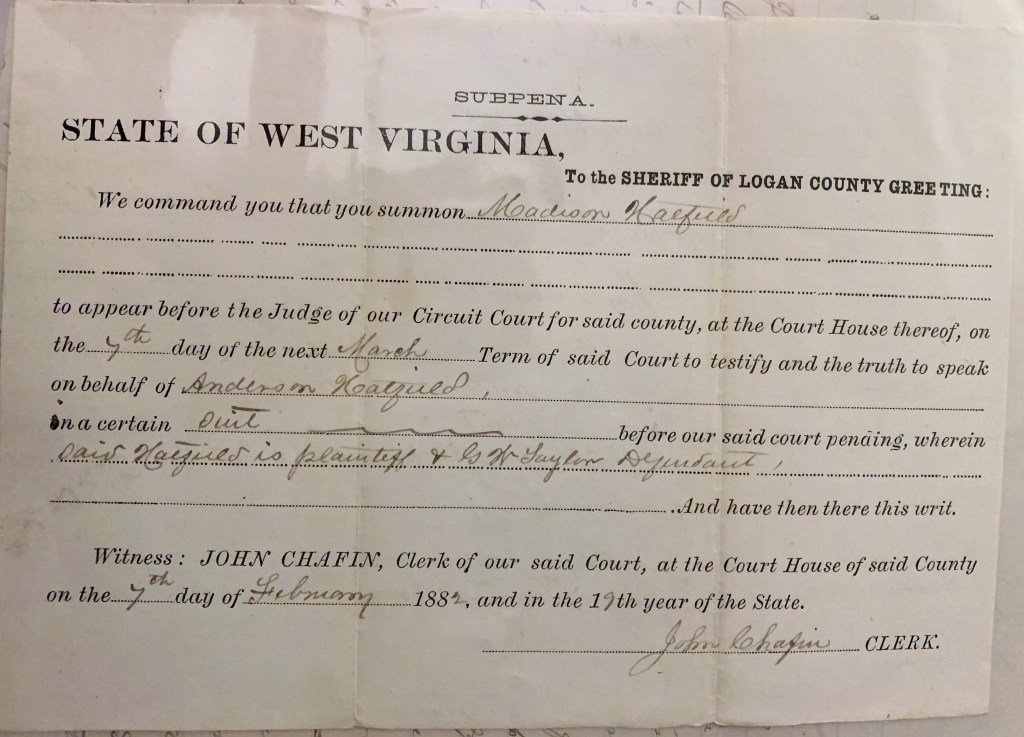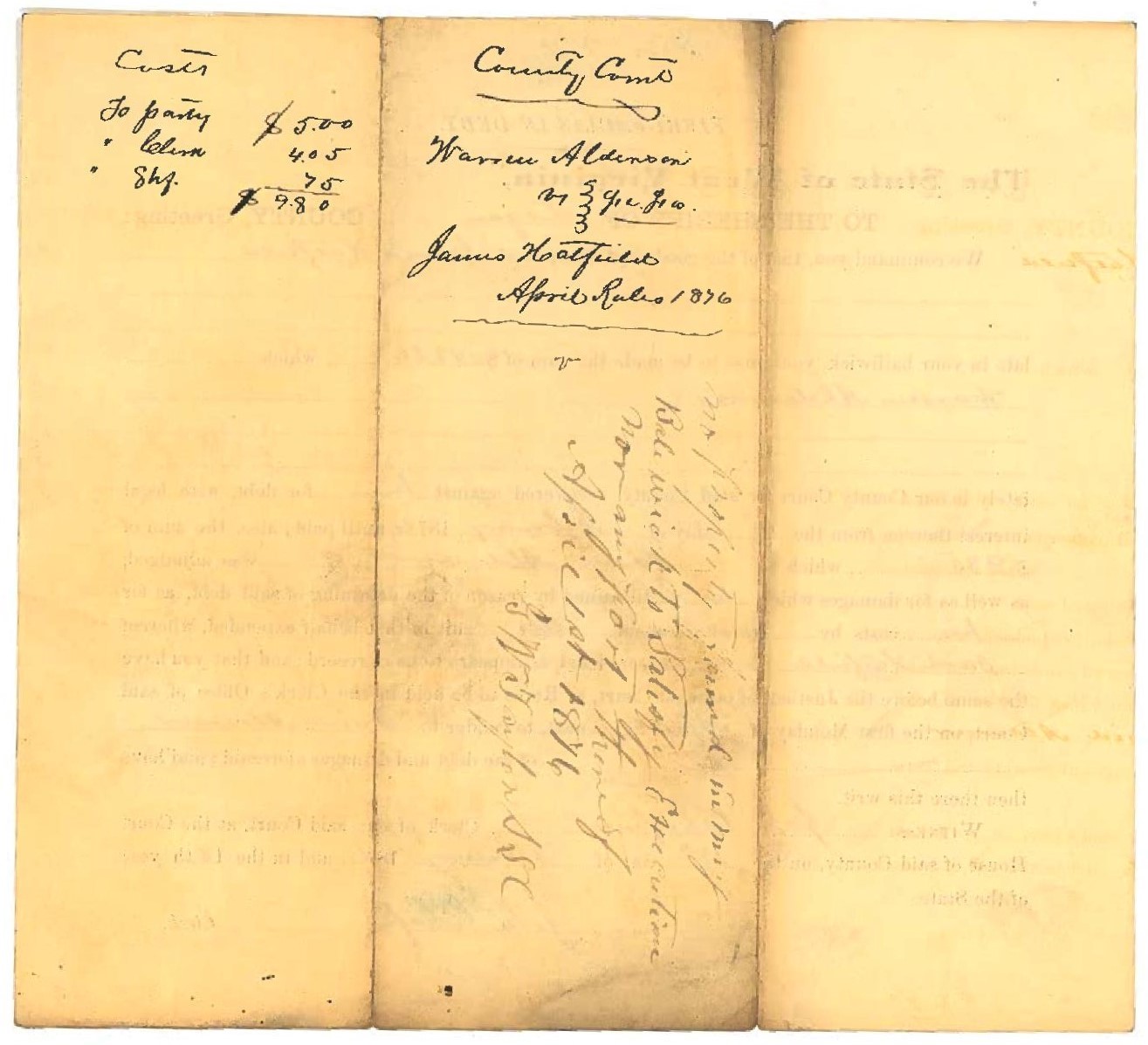Tags
A.A. Hamilton, A.A. Vance, A.J. Browning, A.J. Dalton, Adrian Murphy, Albert Dingess, Albert Gore, Allen Mounts, America Justice, American Surety Company of NY, Anthony Adams, Appalachia, Art Chambers, B.J. Hiner, Bert Bush, Bettie Stollings, Burl Adams, C.A. Vickers, C.P. Donovan, C.W. Gore, Cecil Mounts, Charles H. Miller, Charley Conley, Charley Stollings, Clark Smith, Clay Workman, Cush Avis, D.V. Wickline, David C. Dingess, David Dingess, deputy sheriff, Don Chafin, Dump Farley, E.R. Hatfield, Ed Chapman, Ed Eggers, Elias Thompson, Elizabeth Ellis, Everett Dingess, F.A. Sharp, F.D. Stollings, Frank Hurst, Frank Justice, Frank P. Hurst, Fred Midelburg, G.F. Gore, G.W. Lax, Garland Adams, genealogy, George Butcher, George Chafin, George E. Thompson, George Justice, George Robinette, Georgia Dingess, Green Ellis, Guy F. Gore, H.H. Farley, Harrison Lowe, Harry S. Gay, history, J.B. Toney, J.E. Barlow, J.E. McCoy, J.H. Ford, J.L. Bess, J.L. Chambers, J.M. Moore, J.O. Hill, J.S. Miller, J.W. Chambers, James Ellis, James Toney, Joe Adams, Joe Blair, Joe Hall, Joe Scaggs, John Barker, John Chafin, John D. Browning, John D. Neece, John F. Dingess, John Harrison, John L. Butcher, John T. Gore, Joseph A. Ellis, K.F. Mounts, Katie Mounts, L.D. Perry, L.E. Steele, L.G. Burns, L.H. Thompson, Lewis Butcher, Lewis Chafin, Lewis Farley, Lillie Mounts, Logan County, Martha J. Stowe, Mary Chafin, Mat Jackson, Matilda Stollings, Millard Elkins, Milton Stowers, Monroe Bush, Moses Williamson, Nim Conley, Noah Steele, O.M. Conley, P.J. Riley, Paul Hardy, Pete Gore, R.H. Ellis, R.J. Conley, Riley Damron, Robert Bland, sheriff, Sidney B. Lawson, Simp Thompson, Sol Adams, T.B. Stowe, Taylor Walsh, Tennis Hatfield, Tom Butcher, U.B. Buskirk, Van Mullins, Vincent Dingess, W.E. White, W.F. Farley, W.H. Bias, W.I. Campbell, W.L. Honaker, W.W. Conley, Wash Farley, West Virginia, William Farley, William Gore, William Hatfield, William White, Willis Gore
The following list of Don Chafin’s deputies prior to the Battle of Blair Mountain is based on Record of Bonds C and Record of Bonds D in the Logan County Clerk’s Office in Logan, WV:
Don Chafin was elected sheriff on November 5, 1912 and appeared on December 28, 1912 with his bondsman U.B. Buskirk for $40,000 (Book C, p. 215)
Name, Date of Appointment, Surety, Surety Amount, Book, Page
Garland A. Adams…28 January 1913…J.W. Chambers…$5000…C…236
Joe Adams…14 October 1913…G.F. Gore, A. Dingess, David C. Dingess, Anthony Adams, Sol Adams, Sr., and Sol Adams, Jr….$5000…C…297
John Barker…5 February 1913…F.P. Hurst…$5000…C…241
J.E. Barlow…26 April 1913…S.B. Lawson…$5000…C…268
J.L. Bess…22 July 1916…Fidelity and Deposit Company of Maryland…$5000…D…22
Joe Blair…28 December 1912…J.W. Chambers and Allen Mounts…$5000…C…224
John D. Browning…1 July 1914…Fidelity and Deposit Company…$5000…C…345
Bert Bush…6 January 1913…Monroe Bush…$5000…C…230
John L. Butcher…28 December 1912…Lewis Butcher, J.W. Chambers, Albert Gore…$5000…C…221
George Chafin…12 July 1915…James Toney…$5000…C…402
George Chafin…3 January 1917…J.B. Toney…$5000…D…74
J.A. Chafin…20 June 1913…J.W. Chambers and A.A. Vance…$5000…C…275
John Chafins…31 January 1913…H.H. Farley and A.J. Browning…$5000…C…240
Art Chambers…25 July 1914…Cush Avis, J.L. Chambers…$5000…C…349
Charley Conley…18 June 1914…George Butcher, Ed Chapman, William White…$5000…C…342
Nim Conley…18 July 1913…Ed Chapman and W.W. Conley…$5000…C…281
R.J. Conley…25 March 1913…Albert Gore…$5000…C…252
A.J. Dalton…26 December 1913…Fidelity and Deposit Company of MD…$5000…C…315
Riley Damron…5 July 1913…Millard Elkins and J.E. McCoy…$5000…C…278
David Dingess…3 April 1913…J.W. Chambers and George Justice…$5000…C…254
Everett Dingess…10 November 1913…John F. Dingess and Burl Adams…$5000…C…304
Vincent Dingess…7 July 1913…Georgia Dingess, William Gore, and Albert Gore…C…$5000…279
Ed Eggers…21 April 1913…Paul Hardy…$5000…C…264
Green Ellis…1 January 1917…Don Chafin…$5000…D…78
Joseph A. Ellis…30 January 1913…O.M. Conley…$5000…C…239
R.H. Ellis…undated…Elizabeth Ellis…$5000…C…233
H.H. Farley…29 January 1913…L.E. Steele…$5000…C…237
W.F. Farley…28 December 1912…Robert Bland…$5000…C…223
William Farley…13 January 1914…Wash Farley, A. Dingess, Lewis Farley, G.B. Farley…$5000…C…319
J.H. Ford…16 May 1914…P.J. Riley…$5000…C…336
Harry S. Gay, Jr….15 October 1913…S.B. Lawson…$5000…C…299
Albert Gore…28 December 1912…J.W. Chambers, G.F. Gore, Millard Elkins…$5000…C…222
C.W. Gore…2 January 1917…Fidelity and Deposit Company of Maryland…$5000…D…76
John T. Gore…11 July 1916…G.F. Gore and Lewis Farley…$5000…D…18
Pete Gore…5 December 1916…Fidelity and Deposit Company of Maryland…$5000…D…63
William Gore…31 December 1914…W.E. White, James Ellis…$5000…C…377
Joe Hall…23 April 1913…C.P. Donovan, Paul Hardy…$5000…C…267
A.A. Hamilton…14 June 1913…A.A. Hamilton…$5000…C…273
Paul Hardy…20 February 1913…W.F. Farley…$5000…C…244
John Harrison…19 April 1913…J.S. Miller, M. Elkins, W.E. White, and James Ellis…$5000…C…262
E.R. Hatfield…6 January 1914…$5000…H.H. Farley…C…316
Tennis Hatfield…14 June 1915…James Ellis and Lewis Chafin…$5000…C…396
William Hatfield…28 December 1912…J.S. Miller and George Justice…$5000…C…229
J.O. Hill…17 April 1913…Katie Mounts…$5000…C…261
B.J. Hiner…23 April 1913…C.P. Donovan and Paul Hardy…$5000…C…266
W.L. Honaker…8 August 1916…Fidelity and Deposit Company of Maryland…$5000…D…23
Mat Jackson…13 October 1913…Albert Gore, Van Mullins, G.F. Gore, and David C. Dingess…$5000…C…296
Frank Justice…8 July 1914…America Justice…$5000…C…346
S.B. Lawson…12 April 1913…J.W. Chambers…$5000…C…256
G.W. Lax…21 April 1913…Paul Hardy…$5000…C…263
Harrison Lowe…5 March 1914…no surety [blank]…$5000…C…326
F. Middleburg…16 May 1914…D.V. Wickline…$5000…C…337
Charles H. Miller…25 November 1914…Don Chafin, W.E. White…C…368
J.M. Moore…14 May 1915…American Surety Company of NY…$5000…C…391
Allen Mounts…226
Cecil Mounts…11 June 1913…Allen Mounts…$5000…C…272
Cecil Mounts…2 January 1917…Lillie Mounts…$5000…D…79
K.F. Mounts…28 December 1912…Allen Mounts…$5000…C…225
K.F. Mounts…6 January 1917…Katie Mounts…$5000…D…72
Adrian Murphy…6 February 1917…W.H. Bias and W.E. White…$5000…D…77
John D. Neece…21 March 1914…W.E. White, R.H. Ellis, and J.S. Miller…$5000…C…330
George Robinett…17 July 1913…George Justice…$5000…C…284
Joe Scaggs…231
F.A. Sharp…28 December 1912…W.F. Farley and L.G. Burns…$5000…C…217
Clark Smith…22 December 1913…Mary Chafin…$5000…C…313
L.E. Steele…29 January 1913…H.H. Farley…$5000…C…238
Noah Steele…6 September 1913…L.E. Steele, Jr….$5000…C…290
Charley Stollings…21 July 1913…Matilda Stollings, Tom Butcher, Bettie Stollings, W.I. Campbell, and Milton Stowers…$5000…C…283
T.B. Stowe…13 January 1913…Martha J. Stowe…$5000…C…234
Elias Thompson…16 April 1913…W.I. Campbell and K.F. Mounts…$5000…C…258
George E. Thompson…17 April 1913…A.F. Gore and Willis Gore…$5000…C…260
Simp Thompson…3 October 1916…Fidelity and Deposit Company of Maryland…$5000…D…36
C.A. Vickers…12 January 1914…L.D. Perry and F.D. Stollings…$5000…C…318
Taylor Walsh…28 July 1914…W.E. White, Albert Gore…$5000…C…350
Moses Williamson…29 April 1913…L.H. Thompson…$5000…C…270
Clay Workman…28 December 1912…S.B. Lawson…$5000…C…228
Frank P. Hurst was elected sheriff on November 7, 1916 and appeared on November 28, 1916 with his bondsmen J. Cary Alderson, S.B. Robertson, and R.L. Shrewsbury for $100,000 (Book D, p. 54); deputies appointed after November 1916 may be Hurst–and not Chafin–deputies (a few names are duplicated for this reason, I think)



































